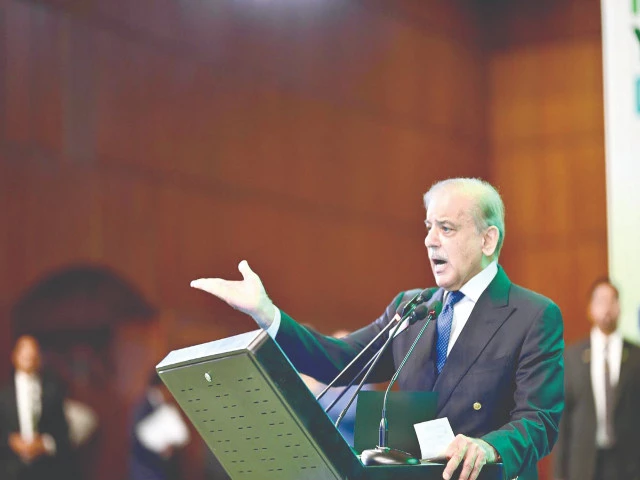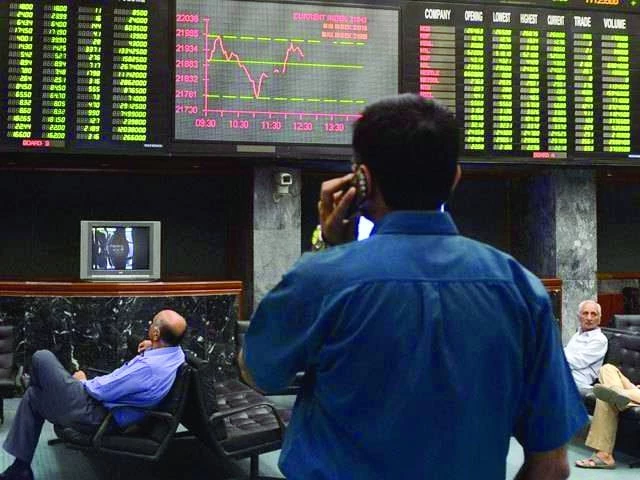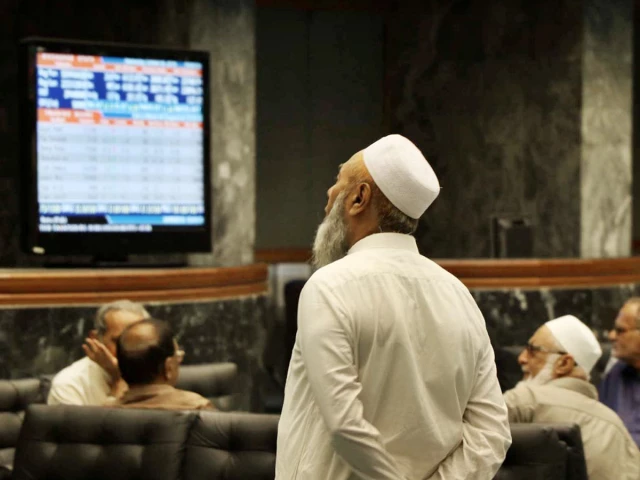Business
PM urged to fast-track spectrum auction | The Express Tribune

ISLAMABAD:
The Pakistan Telecommunication Authority (PTA) has approached Prime Minister Shehbaz Sharif, requesting him to expedite the process of new spectrum auction.
The Senate Standing Committee on Information Technology and Telecommunication, which met on Monday, voiced concerns over Ufone’s continued financial losses. It also got a briefing on alleged overbilling by Jazz, cartelisation in the telecom sector and the persistent service quality issues.
The Senate penal was informed that service quality problems primarily stemmed from the delay in spectrum auctions. Pakistan is currently operating with 274 MHz of spectrum, which is insufficient to meet the rising consumer demand. Internet slowdowns were the result of limited network capacity while several spectrum-related cases remained pending in courts.
Speaking in the meeting, PTA Chairman Hafeezur Rehman said that the shortage of spectrum was a major factor behind poor service quality, though the PTA was fully prepared for spectrum auctions. He noted that Ufone-Telenor merger had been delayed for 18 months, further straining the telecom market.
PTA has also requested the PM to fast-track spectrum auctions in an effort to improve service delivery.
The Senate committee was concerned over the continued losses of Ufone that impacted the financial health of Pakistan Telecommunication Company Ltd (PTCL). The losses of Ufone, a subsidiary of PTCL, have also halted PTCL-Telenor merger.
The PTA chairman asserted that Ufone was the only mobile services company that was incurring losses, while others were profitable.
Senator Humayun Mohmand claimed that the company continued to suffer owing to the influence of the government. However, Senator Afnanullah countered that Ufone’s management was entirely private and the state had no operational role in it.
The PTA chairman acknowledged that Jazz increased tariffs by 19% in 2024, but insisted that the regulator’s role was to maintain market balance. PTA officials told the committee that Jazz wanted to increase tariffs further but it was restrained.
When asked by the committee chair if the PTA supported Jazz’s tariff hikes, the PTA chairman replied: “I will not defend Jazz under any circumstances.”
He clarified that the telecom authority regulates tariffs and protects consumers and no company could increase tariffs without prior approval. He stressed that the objections raised in an audit report had already been addressed and they were based on misunderstanding.
Business
Dr Reddys, Titan & more: Top stocks to buy on December 3 — Check list – The Times of India

HSBC has a buy on Dr Reddys Labs with the target price at Rs 1,430. Analysts said that the semaglutide opportunity is intact for Dr Reddy’s in Canada, and it has replied to Health Canada’s queries on its application. GLP-1 drugs class remains the company’s focus segment and it is making progress in long-term drivers like biosimilars. Health Canada approval for generic semaglutide will be a key catalyst for the stock.Goldman Sachs has a buy on Titan with the target price at Rs 4,500. Analysts said the company expects a 15-20% growth in its jewellery business in the medium term. The company is maintaining jewellery margins despite headwinds. Its consolidated earnings before interest and taxes (EBIT) growth is ahead of standalone jewellery EBIT growth, driven by the strong trajectory of Caratlane, watches and other businesses. Titan’s eyewear business is strong in the premium segment and it is exploring how to address the mass market opportunity.Bernstein has and outperform rating on Trent with the target price cut to Rs 5,000. Analysts said they believe that the company’s revenue growth now is at a bottom. From here on the key drivers of recovery are like-for-like for split stores turns positive with base effect, about 20% compounded annual growth rate in Zudio network for three years, improved consumer demand cycle and growth in Westside business. On the other hand the key risk remains the competitive upsurge (more stores and replicating Zudio’s fashion sense and demand pull).CLSA has an outperform rating on Power Grid Corp with the target price at Rs 342. Analysts said that the company’s entry into the battery energy storage systems (BESS) should be a positive surprise with it emerging as a preferred bidder for a 150MW project. The company’s strategy of entering adjacencies such as BESS inside a transmission substation as it is likely to win the BESS concession at 11% above the price of lowest bid. They expect the company to scale-up its BESS portfolio to multi-GW with its competitive advantage of a 100 basis points (= 1 percentage point) lower interest rate versus private competitors.Macquarie has an outperform rating on ITC with the target price at Rs 480. Analysts said that the govt is proposing a new cess on cigarettes, which is likely to replace the compensation cess. This new levy increases uncertainty on taxation for the players, analysts said. In turn this could involve a transition period for things to adapt and normalise to any new system.(Disclaimer: Recommendations and views on the stock market, other asset classes or personal finance management tips given by experts are their own. These opinions do not represent the views of The Times of India)
Business
Your FDs, RDs, SIPs Are Growing, But Are They Useless? The Biggest Mistake 90% Don’t Even Notice

Personal Finance Tips: Most of us keep saving money through fixed deposits (FDs), recurring deposits (RDs), provident fund (PF) accounts or systematic investment plans (SIPs) without giving it the thought it actually deserves. The bank deduction goes through, the balance inches up, the graph rises and everything looks fine on the surface.
But underneath this rhythm sits a truth that people are saving diligently without knowing what that money is supposed to do for them. This is a money trap that almost everyone walks into.
Investments keep running, but the purpose disappears. The amounts grow, but the “why” behind them turns vague. Once that emotional connection breaks, the whole act becomes routine and lifeless.
Why Does This Happen?
Most people say they are saving for retirement or putting money aside for the future. These answers sound responsible but reveal very little. What does retirement look like? What kind of future are we imagining? When the mind cannot see a clear picture, it refuses to bond with the goal. That is when investing becomes a cold task.
FDs continue because they have always existed. SIPs continue because the automatic deduction is fixed. After a point, this cycle becomes tiring. Savings continue, but the inner reason for saving slips out of sight.
Purpose Mapping
Purpose Mapping reminds you that money is not meant to lie dormant but to support the kind of life you want. It brings your financial decisions back into your emotional world.
Instead of thinking in numbers, you begin by imagining how you actually want your daily life to look. A person may say, “I want the freedom to shift to a smaller town by the age of 45,” or “I want to be able to take a six-month career break without fear or stress,” or even, “If something serious happens at home, I should not feel helpless.”
These statements breathe. They feel real because you can see them unfolding.
Once these lived goals come into focus, the structure of your investments naturally aligns with them. The SIP you invest in each month becomes the cushion for a future career pause. The FD becomes a tool for near-term needs. The emergency fund becomes a source of mental peace rather than an afterthought. At this stage, you are no longer saving out of habit; you are investing with intention.
The emotional link becomes even stronger when each part of your financial plan is tied to a feeling (freedom, safety, peace or control). When money stands for something human, the motivation behind saving never dries up. And when you keep your goals visible, sometimes literally, sometimes in the back of your mind, the process becomes far easier. You no longer feel that you are losing money to deductions; you feel that every deduction is building a specific life.
Life keeps changing, and so should your goals. A review every year helps your investments change in step with you. When your plans move with your life, saving no longer feels like a burden. It becomes a way of staying ready for the life you want to live.
Business
American Eagle stock jumps 10% as it expects a big holiday, raises forecast after Sydney Sweeney ads

An American Eagle advertisement featuring actress Sydney Sweeney on a billboard in Times Square in New York, US, on Thursday, Aug. 7, 2025.
Michael Nagle | Bloomberg | Getty Images
American Eagle issued bullish holiday guidance and raised its full-year forecast on Tuesday after posting better-than-expected quarterly results.
The apparel company is expecting fiscal fourth quarter comparable sales to grow between 8% and 9% – about four times better than the 2.1% analysts had anticipated, according to StreetAccount.
American Eagle is now expecting its full year adjusted operating income to be between $303 million and $308 million – up from its previous range of $255 million to $265 million.
American Eagle shares rose as much as 15% in extended trading.
The company beat third-quarter expectations on the top and bottom lines.
Here’s how American Eagle did during the quarter compared with what Wall Street was anticipating, based on a survey of analysts by LSEG:
- Earnings per share: 53 cents vs. 44 cents expected
- Revenue: $1.36 billion vs. $1.32 billion expected
The company’s reported net income for the three-month period that ended Nov. 1 was $91.34 million, or 53 cents per share, compared with $80.02 million, or 41 cents per share, a year earlier.
Sales rose to $1.36 billion, up about 6% from $1.29 billion a year earlier.
The results are the first time investors are seeing a full quarter of impact from American Eagle’s splashy campaigns with Sydney Sweeney and Travis Kelce.
Companywide, American Eagle saw comparable sales grow 4%, better than the 2.7% analysts had expected, according to StreetAccount. While the business’s overall results topped expectations, they were primarily driven by Aerie, which saw comparable sales rise 11% and revenue jump about 13%.
At American Eagle, where the campaigns were focused, comparable sales grew just 1%, worse than the 2.1% analysts had expected, according to StreetAccount.
The company told CNBC the campaigns are “attracting more customers” and creating more attention around the brand, but the results show they have not yet been a major revenue driver.
However, they’re not having a major impact on profits, either. During the quarter, American Eagle’s operating margin was 8.3%, better than the 7.5% analysts had expected, according to StreetAccount.
Beyond its marketing campaigns, American Eagle told CNBC it saw record revenue in its third quarter and that “strong momentum” carried into the current quarter, where it saw a “record breaking Thanksgiving weekend.”
The rosy holiday commentary comes after peers like Abercrombie & Fitch, Gap and Urban Outfitters posted better than feared results ahead of the crucial holiday shopping season. Investors have been watching discretionary retailers closely to look for slides in consumer demand because of tariffs, but many have proven resilient so far. They’re showing that for now, higher prices aren’t stopping consumers from shopping, as long as they feel like they’re getting good value for their money.
Industrywide holiday outlooks from outside consulting firms have been relatively murky, but the latest slate of earnings from discretionary retailers have been a positive omen for holiday sales. Plus, turnout during the so-called Turkey 5 shopping weekend, the five day stretch between Thanksgiving and Cyber Monday, was stronger than expected, according to the National Retail Federation.
-

 Sports1 week ago
Sports1 week agoWATCH: Ronaldo scores spectacular bicycle kick
-

 Entertainment1 week ago
Entertainment1 week agoWelcome to Derry’ episode 5 delivers shocking twist
-

 Politics1 week ago
Politics1 week agoWashington and Kyiv Stress Any Peace Deal Must Fully Respect Ukraine’s Sovereignty
-

 Tech3 days ago
Tech3 days agoGet Your Steps In From Your Home Office With This Walking Pad—On Sale This Week
-

 Tech1 week ago
Tech1 week agoWake Up—the Best Black Friday Mattress Sales Are Here
-

 Fashion2 days ago
Fashion2 days agoResults are in: US Black Friday store visits down, e-visits up, apparel shines
-

 Sports2 days ago
Sports2 days agoIndia Triumphs Over South Africa in First ODI Thanks to Kohli’s Heroics – SUCH TV
-

 Entertainment2 days ago
Entertainment2 days agoSadie Sink talks about the future of Max in ‘Stranger Things’









